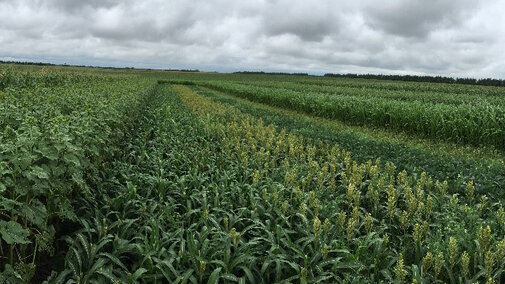Farmers throughout the Corn Belt may want to consider diversifying traditional corn and soybean rotations to increase agronomic sustainability and to spread financial risks associated with low market prices of corn and soybean. An alternative is a more diverse crop rotation using field pea (short-season grain crop) followed by cover crops, forages, or short-season crops (Figure 1).

Field peas are planted mid-March and harvested in early July providing a window of opportunity to extend the growing season by double cropping. Potential benefits of this alternative rotation include reducing tillage, fertilizer, and herbicide inputs; minimizing soil erosion and compaction; increasing the efficiency of cropping system water use; building up soil organic matter; suppressing weeds and pests; and reducing nitrate leaching.
Treatment and Study Design
- Field pea variety trial with 32 varieties
- Field pea harvested on July 12
- Short-season crops and forage sorghum planted on July 12
- Sudangrass and cover crops planted on July 22
- Site: Mead
- Field pea, lentils, and chickpea were planted mid-March. The field pea variety trial was harvested in early July, lentils in late July, and chickpea in early August.
- Average grain yields for yellow pea, green pea, lentils, and chickpea were 37, 38, 30 and 37 bushels/acre, respectively.
- Corn (P7213R), soybean 2.0 MG (RX1827), grain sorghum (SP 25C10), grain sorghum (NK 2212), proso millet (Huntsman), sunflower (MY8H456CL), and forage sorghum (CaneX) were planted right after field pea harvest (early July). Cover crop (winter-sensitive and winter-hardy) mixes and Sudangrass were planted in late July.
- Soil water content was monitored throughout the growing season (July to November) on a daily basis using watermark sensors.
- Cover crops, Sudangrass, and forage sorghum yielded 3,600, 7,000 and 11,000 pounds/acre, respectively. Plants were cut for total biomass estimation on September 7, 2018.
- Average grain yields for corn, soybean, and grain sorghum were 26, 11, and 96 bushels/acre, respectively. Sunflower and proso millet grain yields were 1725 pounds/acre each.
At the conclusion of this project, farmers will be able to
- identify the circumstances when replacing corn or soybean with a field pea double crop will be economically viable and how using such a system can improve soil nutrient cycling, water use, and total plant biomass; and
- select best-suited cover crop, forage, or short-season crop following field pea for double cropping to diversify their corn-soybean crop rotation and spread production risks.

